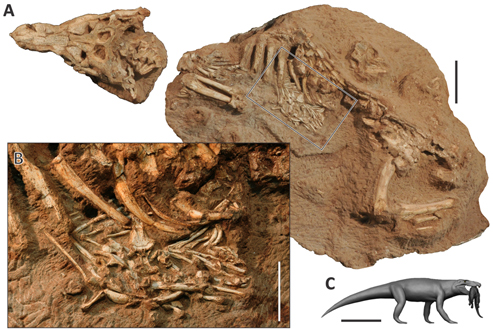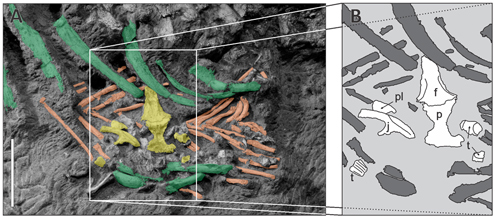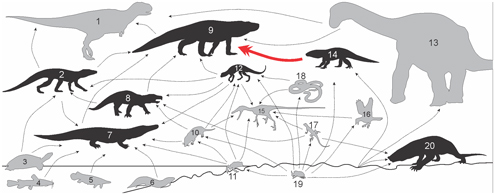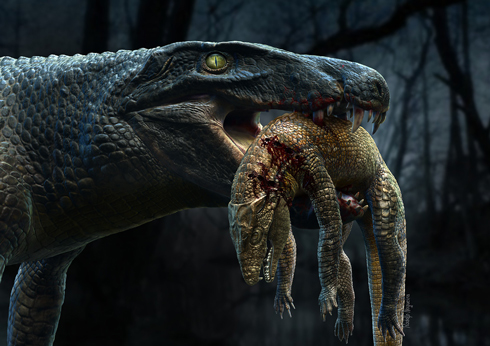“Gluttonous and Filthy” – New Species of Cretaceous Crocodile
Aplestosuchus sordidus – Fearsome Late Cretaceous Predator from Brazil
When it comes to naming new species, a candidate for the best and most appropriately named in 2014 has got to be Aplestosuchus sordidus. Aplestosuchus was a crocodilian that roamed south-central Brazil in the Late Cretaceous. The name means “gluttonous and filthy crocodile”, for found in the body cavity of this nearly complete specimen was the remains of its last meal – another crocodile. Direct fossil evidence of interactions between extinct species of crocodiles is extremely rare, but this fossil shows that large crocodyliforms ate smaller crocodyliforms and more importantly, it helps scientists to understand a little more about the food chain that existed in this part of South America around eighty million years ago.
Aplestosuchus sordidus
A scientific paper on the newly described species of crocodile, a distant relative of today’s extant crocodiles, has just been published in the academic journal “PLOS One”. The fossils were found in a rocky outcrop, close to a small river. The strata at this location makes up part of the Adamantina Formation which has been tentatively dated to the Turonian to Santonian faunal stages of the Late Cretaceous, although some strata that form the upper layers of this formation may be younger, dating from the Campanian faunal stage.
A number of crocodyliform fossils have been found in the Adamantina Formation. During the Cretaceous, crocodiles occupied many more niches in food chains than they do today. There were terrestrial forms as well as species more adapted to a semi-aquatic lifestyle. Some evolved heavy armour and whilst predominately a clade of carnivores, a number of fossils show evidence of herbivory.
Excavating and Preparing the Fossil
This fossil of Aplestosuchus was recovered from two blocks, the first of which contained a nearly complete, although somewhat compressed skull and jaws. The second block contained most of the rest of the body, just elements from the end of the tail and the hind limbs were missing.
The animal fossil remains measured just over a metre in length and it has been assigned to the Baurusuchidae family of crocodyliforms, terrestrial predator crocodiles in which some species exceeded four metres in size. Inside the body cavity of this specimen was the remains of a small, not yet fully described species of crocodile, which has been assigned to the Sphagesauridae family. Sphagesaurid crocodiles, themselves evolved into a variety of forms and are distantly related to the Baurusuchidae.
Cretaceous Crocodile
The scientists who studied the fossilised stomach remains have concluded that given the relative size of the two fossil specimens, it is likely that the larger Aplestosuchus attacked and killed the smaller crocodile. This is cited as evidence of predator/prey interaction and not a case of A. sordidus scavenging a carcase.
Fossil Crocodiles Showing Evidence of a Predator/Prey Relationship
Picture credit: PLOS One
The picture shows (A) skull material in one block with the rest of the fossil remains located in a larger adjacent block, scale bar = 10 cm. Picture B, is a close up of the body cavity showing evidence of predation, scale bar 5 cm.
The illustration (C) shows a drawing of the larger crocodyliform with the prey in its mouth (scale bar = 50 cm).
Examining the Body Cavity
Examination of the abdominal cavity revealed the presence of skull bones and a tooth from the smaller sphagesaurid crocodile. This location has yielded a number of crocodyliform fossils, something like twenty different species have been identified so far. It is not known whether this particular part of South America proved to be a locus for extensive crocodyliform radiation, or whether there is a strong bias towards crocodiles within the fossil record at these sites.
A Colour Coded Image Showing a Close Up of the Stomach Contents
Picture credit: PLOS One
Photograph A shows the green ribs of A. sordidus, the belly ribs (gastralia) are highlighted in orange. The remains of the smaller sphagesaurid are shown in yellow, with diagram B providing a key to sphagesaurid fossil bones found: f, frontal; j, jugal; p, parietal; pl, palpebral; t, tooth.
Scale bar = 5 cm.
Formidable Predators
Baurusuchid crocodiles were formidable predators and in the absence of theropod dinosaurs, larger species would have probably occupied the position of apex predators within the terrestrial environments of south-central Brazil during the latter stages of the Cretaceous. The skull although compressed, indicates that Aplestosuchus sordidus had a formidable bite and the largest teeth in the jaws are over 2 cm in size.
A Lateral (side) View of the Skull of A. sordidus
Picture credit: PLOS One/Everything Dinosaur
The Adamantina Formation has provided researchers with a wealth of Late Cretaceous fossil material. As a result, a picture of the fauna that existed has been built up, but until now it was not certain how the food chain relating specifically to crocodyliforms was set up. This fossil material suggests that, as previously thought, the Baurusuchidae occupied an apex predator position. Only a handful of theropod dinosaur fossils have been found.
These specimens represent a miscellany of meat-eating dinosaurs and no genera have been successfully ascribed from the fossil evidence. Teeth fossils along with fragmentary body fossils indicate the presence of large, carnivorous dinosaurs (abelisaurids, carcharodontosaurids, or possible other tetanurans). As fossils of large herbivorous dinosaurs (titanosaurs) have been found in this formation, it is likely that big theropods co-existed with them but in this instance the fossil evidence suggests that crocodiles made up a significant proportion of the predators within this environment.
Suggested Food Web Reconstruction (Adamantina Formation) South-Central Brazil
Picture credit: PLOS One
The red arrow indicates the predator/prey relationship between the Baurusuchidae and sphagesaurids.
Key
1, Large theropods (Abelisauridae, Charcarodontosauridae, Megaraptora); 2, Peirosaurids (Montealtosuchus arrudacamposi, Pepesuchus deiseae); 3, Turtles (Bauruemys elegans, Roxochelys wanderleyi); 4-6, Fishes (Teleostei, Lepisosteidae, Dipnoi); 7, Trematochampsids (Barreirosuchus franciscoi); 8, “Notosuchians” (Labidiosuchus amicum, Mariliasuchus amarali, M. robustus, Morrinhosuchus luziae); 9, Baurusuchids (Baurusuchus albertoi, B. pachecoi, B. salgadoensis, Campinasuchus dinizi, Gondwanasuchus scabrosus, Pissarrachampsa sera, Stratiotosuchus maxhetchi); 10, Mammals; 11, Anurans; 12, Adamantinasuchus navae; 13, Sauropods (Adamantisaurus mezzalirai, Aeolosaurus maximus, Gondwatitan faustoi, Maxakalisaurus topai, Nemegtosauridae); 14, Other sphagesaurids (Caipirasuchus paulistanus, Caryonosuchus pricei, Sphagesaurus huenei, S. montealtensis); 15, Unenlagiines; 16, Birds (Enantiornithes); 17, Lizards (Brasiliguana prudentis); 18, Snakes (Anilioidea); 19, Insects (Coleoptera); 20, Armadillosuchus arrudai.
This latest research highlights the significant diversity of crocodiles and it also provides evidence of predator/prey interactions amongst crocodyliforms. The artwork created by Rodolfo Nogueira which accompanied the PLOS One paper is superb. As well as demonstrating robust academic vigour, the research team involved in this study have been able to provide a vivid illustration that interprets this fossil evidence.
Aplestosuchus sordidus Preying on a Unknown sphagesaurid
Picture credit: Rodolfo Nogueira
If the fossil evidence is anything to go by, then Aplestosuchus sordidus “gluttonous and filthy crocodile” has been appropriately named.






